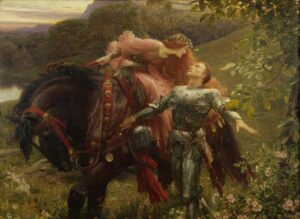My first introduction to this poem was the absolutely gorgeous painting of the same name by Frank Bernard Dicksee. I love it so much that it is hanging in my dorm room, and now having read the poem in this class (finally), the painting takes on a whole new meaning. While Dicksee depicts the romance between the knight and the fairy maiden as loving and fantastical, awash in bright colors and longing gazes, the poem by Keats is less about the romance and more about the danger of it. I argue that Keats’ La Belle Dame Sans Merci warns against obsessive love using the frame of a medieval romance, and that the metaphors and descriptors he uses ultimately describe a metaphorical death for the knight.

The story follows the very basic plot of an ‘otherworldly romance,’ which are very common in the courtly romances of the Middle Ages. I took a class on Medieval Romance literature last semester, and wrote my final paper on the complicated and independent nature of these otherworldly female fairy lovers. Essentially, in a majority of these romances, female fairies arrive in ‘our world’ (or the world of knights and kings) to offer herself as a lover to some worthy man, either with happy or disastrous results. In Keats’ poem, ‘La Belle Dame Sans Merci’ (or ‘The Beautiful Lady without Mercy’) takes on a deceitful role, luring the knight in with her beautiful appearance and “fairy’s song” (Line 24).
The essential point of this recounting of the experience, to me, is when the knight tells of how there was “nothing else [I] saw all day long,” which alludes to his overwhelming obsession with his lover (Line 22). After he meets this lady in the meadow, he cannot do or think of anything else but her, and when “she lulled me asleep” he saw the other “death-pale” past lovers of the lady (Line 33, 38). I argue that when the knight enters this slumber, he metaphorically dies due to the loss of his lady.
Keats hints at this death with how the poetic speaker describes the knight after he has ‘awoken’ — he asks twice “Oh, what can ail thee, knight-at-arms” and describes the man as “alone and palely loitering,” “haggard and so woe-begone,” and almost withering away (Line 1, 2, 5, 6). The repetition of specific phrases and the structure of the questions quickly establish the disheveled and dissociative state of the knight. Keats then employs two metaphors to discuss the knight’s appearance, with the speaker mentioning how they “see a lily on thy brow” (Line 9). The whiteness of the lily can allude to the paleness of the knight, but lily’s also represent grief and death, which the knight seems to embody. The speaker also mentions a “fading rose” on his cheek, which is both the fading color from his complexion (which connects to the pale and sickly appearance of the knight) and the fading of love, which the rose symbolizes.
Although the poem does center around the love affair with the lady, to me it is not the main focus of the poem. Unlike the painting which depicts the love affair as perfect, romantic, and otherworldly, Keats spends more time describing and capturing the grief and distress of the knight after the lady abandons him. The knight seems to undergo a metaphorical death, or at least he is close to it when the speaker finds him. Heartbroken, sickly, and alone, the knight’s tale seems to warn against the dangers of obsessive love.

As someone who has read this poem in the past, I also love the gorgeous painting that goes with it. I really enjoyed reading your blog post. I noticed this theme of bewitching otherworldly women in one of our other assigned poems, “Christabel.” Specifically, the character of Geraldine. Geraldine also has this bewitching quality and is seemingly able to place Christabel under a spell. There is a seductive air to this spell, and I wonder what you make of the relationship between fairy lady and exploited lover in a queer context. Although Christabel and Geraldine’s relationship is more implicit than explicit, I think it is worth analyzing why the otherworldly seductress is a common medieval and romantic trope and how a queer adaptation may complicate her.
I really like how you tie in the painting with the poem and how you discuss the use of the rose and lily to describe the knight after he has lost his fairy lover. Building off of that, I think that plants in general play a big role in this poem. the sedge is used to set the “withered” scene at the start and end of the poem. Keats also incorporates plants as “gifts” in this poem by having the knight give the fairy a garland and her give him “roots of relish sweet” (l. 25).
I am so glad you brought the painting into your blog post. I have always found the painting and poem fascinating to compare because to me they feel very different from each other at first glance, but the more you look the more unsettling the painting becomes (especially when you have the poem for context). The painting does an excellent job of capturing the overwhelming feeling of love between the knight and the fairy- the colors and beautiful landscape make it feel safe and loving. When we explore the meanings of the poem, however, it’s obvious that, as you said in your blog post, the poem acts more as a warning than a love story. This aspect of the poem is captured in the poses of the couple, as the fairy almost looms over the knight who is almost grimacing; which reflects obsession and heartbreak very well in their physicality.